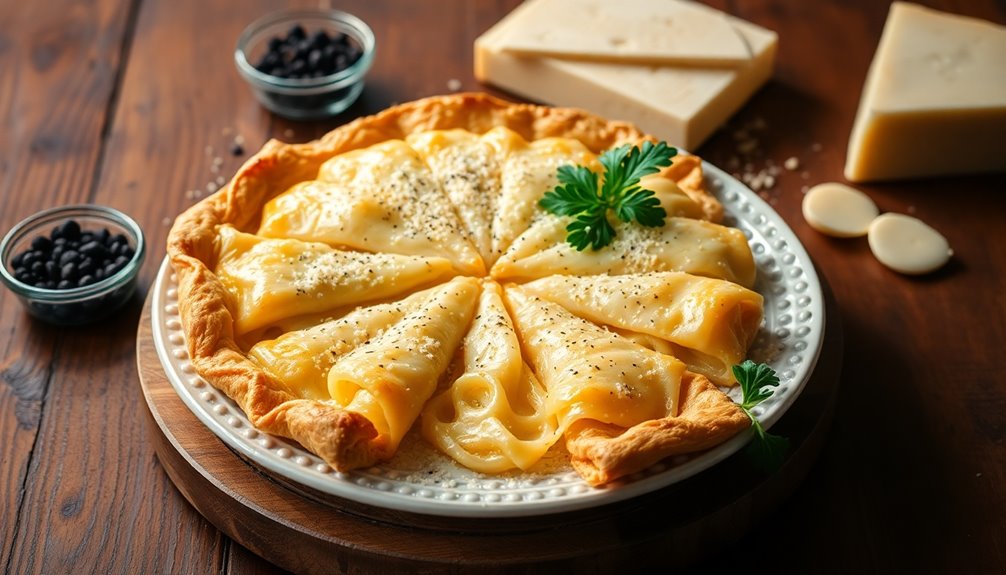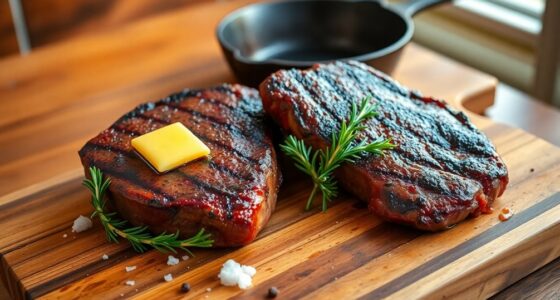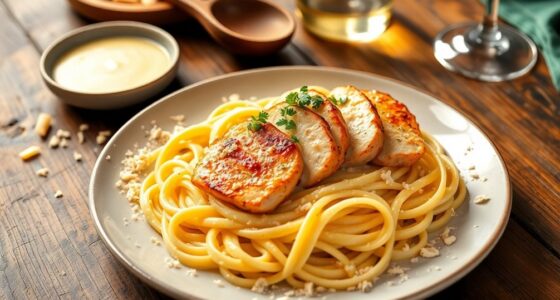Cacio e Pepe Pie takes the beloved Roman dish and turns it into a comforting baked meal. It features a crispy pasta crust filled with a creamy mixture of cheeses, eggs, and black pepper. You'll start by cooking bucatini pasta and mixing it with the cheese blend before baking it to golden perfection. This dish serves 6 to 8 people, making it perfect for gatherings or cozy dinners. Discover more tips and variations to make it your own!
History
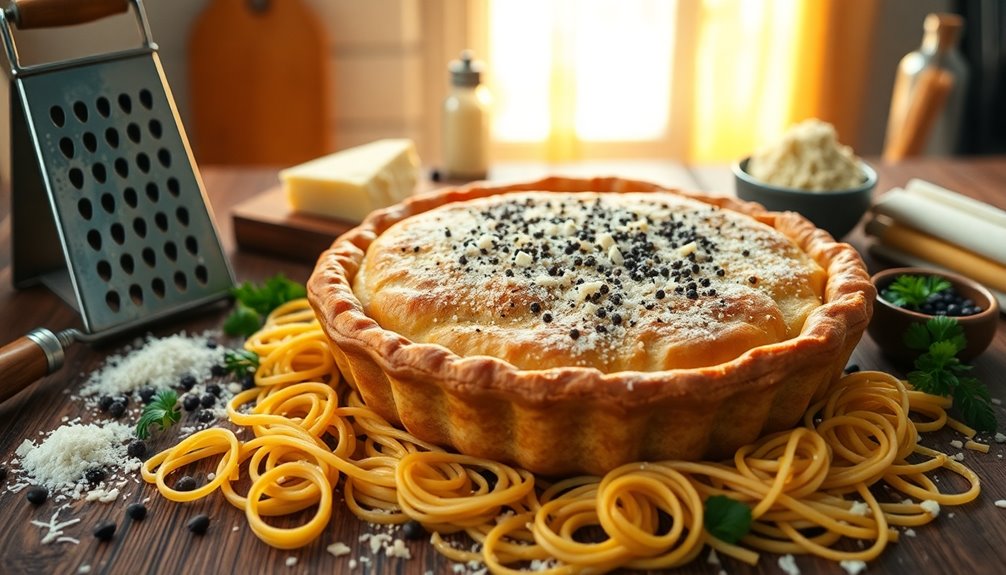
Cacio e Pepe, which means "cheese and pepper," has roots that stretch back to ancient Rome, where it was a staple for shepherds in the Lazio region.
This traditional Italian dish uses just three ingredients: pasta, Pecorino Romano cheese, and black pepper. Shepherds appreciated its simplicity and convenience, making it easy to prepare while tending their flocks.
Over time, Cacio e Pepe gained popularity beyond Italy, especially in the United States, where it inspired creative adaptations like the Cacio e Pepe Pie.
This baked pasta dish showcases the creamy cheese and pepper flavors you love, offering a comforting twist on the classic.
The evolution of Cacio e Pepe reflects a broader trend in contemporary cuisine, celebrating the versatility of pasta and cheese.
Recipe
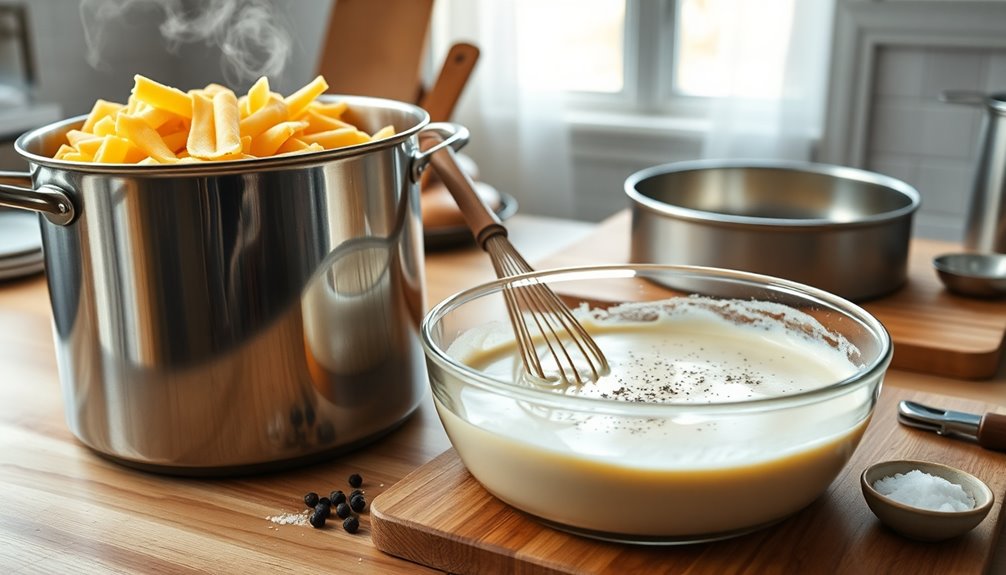
Ingredients:
- 12 ounces bucatini pasta
- 1 ½ cups grated Parmigiano-Reggiano cheese
- 1 cup milk
- 4 large eggs
- 2 teaspoons freshly ground black pepper
- Salt, to taste
- Butter, for greasing the pan
Instructions:
Begin by preheating your oven to 425°F and greasing a 9-inch springform pan with butter.
Cook the bucatini pasta in a large pot of salted boiling water until al dente, following the package instructions.
While the pasta cooks, whisk together the eggs, milk, grated Parmigiano-Reggiano cheese, and black pepper in a large bowl.
Once the pasta is cooked, drain it well and immediately add it to the cheese mixture, stirring to combine thoroughly.
Pour the mixture into the prepared springform pan and spread it evenly.
Bake for 35 to 45 minutes, or until the top is golden and bubbly.
Allow the pie to cool for 10 to 15 minutes before slicing and serving.
Extra Tips:
For a unique twist on your Cacio e Pepe Pie, consider adding sautéed vegetables like spinach or mushrooms, or incorporate meats such as pancetta for added flavor.
If you prefer a creamier texture, you can increase the amount of milk or cheese in the mixture.
Be sure to keep an eye on the pie while it bakes, as oven temperatures can vary, and you want to achieve that perfect golden crust. Air purifiers can significantly improve your kitchen's air quality by reducing cooking odors while you prepare this dish.
Leftovers can be easily reheated, making this dish a great option for meal prep or quick weeknight dinners.
Enjoy experimenting with different flavors and ingredients!
Cooking Steps
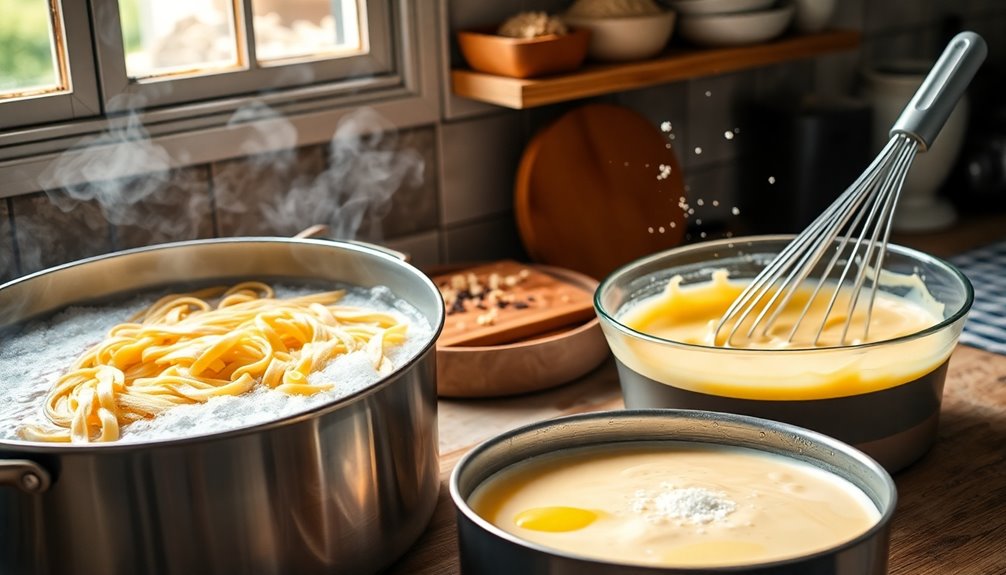
To get started on your Cacio E Pepe Pie, you'll first boil the pasta until it's al dente.
Next, mix together your cheeses and pepper before adding the pasta to the cheesy blend.
Finally, bake it until it's golden brown and irresistible!
Step 1. Boil Pasta Until Al Dente
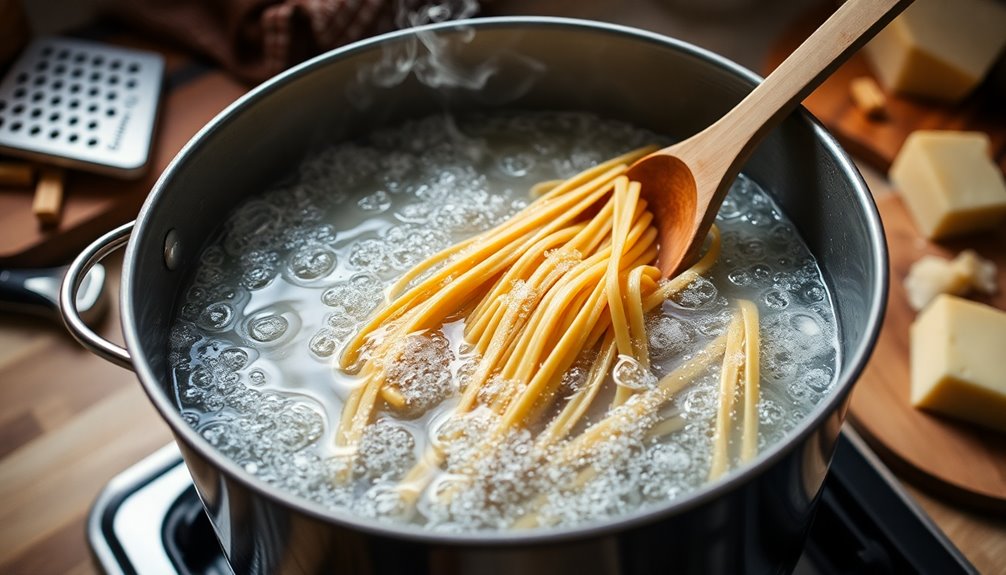
Bring a large pot of well-salted water to a rolling boil to kick off your pasta cooking.
Once boiling, add the bucatini, making sure you've got at least 4-5 quarts of water for ideal cooking.
Cook the bucatini for about 5 to 6 minutes, which is usually 2 minutes less than the package instructions.
Stir occasionally to prevent clumping and make certain of even cooking.
To check for doneness, taste the pasta a minute or two before the recommended time; it should have a firm texture, not hard in the center.
After draining, immediately rinse under cold water to stop the cooking process.
This step's vital before you mix it with the cheese and egg mixture.
Step 2. Mix Cheese and Pepper
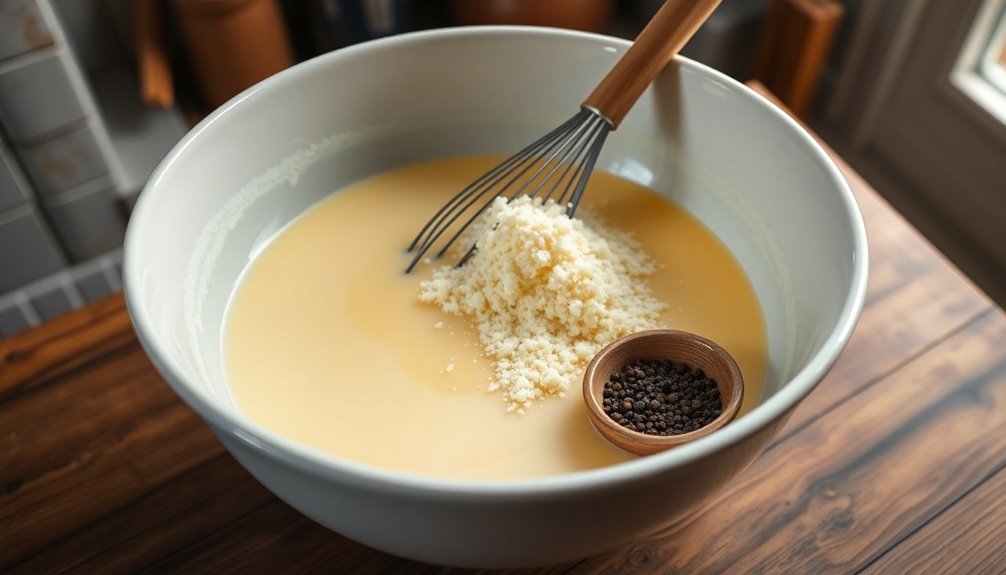
After rinsing the pasta, you're ready to create the flavorful cheese and pepper mixture that will bring your Cacio e Pepe Pie to life.
Start by combining grated Parmigiano-Reggiano, mozzarella, and a touch of provolone in a bowl. Add freshly ground black pepper for that essential kick.
In a separate bowl, whisk together large eggs and a splash of milk, then mix this custard-like blend into the cheese mixture until smooth. Make sure everything's fully incorporated for a creamy texture.
Reserve some cheese for topping later, which will create a bubbly, golden crust during baking.
This cheese mixture is the heart of your Cacio e Pepe Pasta, so take your time to get it just right!
Step 3. Add Pasta to Cheese Mixture
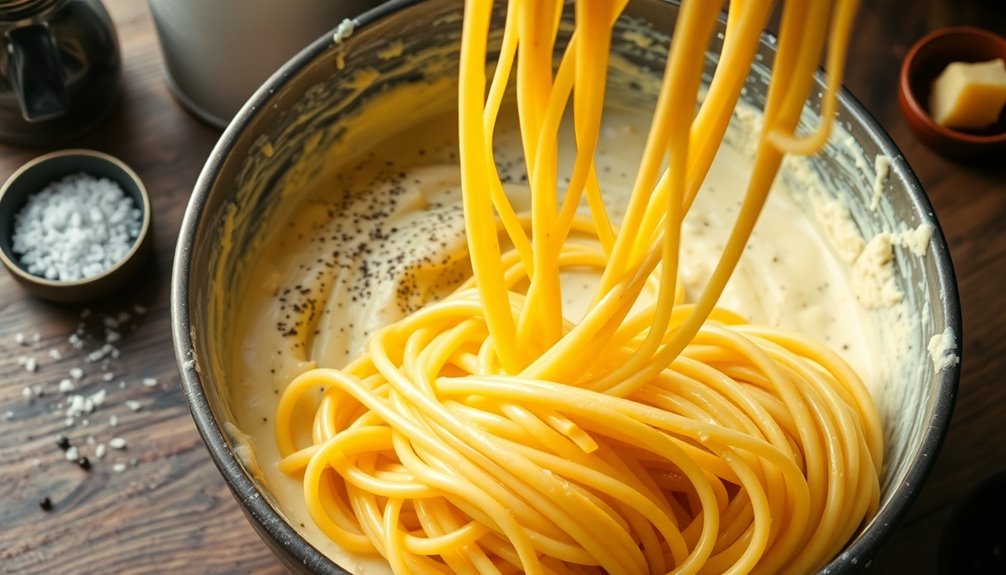
Once your pasta has cooled slightly, it's time to combine it with the cheese mixture.
In a large bowl, you've whisked together milk, eggs, cheese, garlic, pepper, and salt until smooth.
Now, gently toss the pasta, which should be al dente, into the cheese mixture. Make sure each strand is evenly coated for the best flavor in your Cacio E Pepe Pie.
Before mixing, remember to reserve some cheese for sprinkling on top later.
Once everything's well combined, carefully transfer the coated pasta and cheese mixture into a prepared springform pan.
Spread it out evenly, flattening it for even cooking.
Let it cool slightly before moving on to the next step.
Step 4. Bake Until Golden Brown
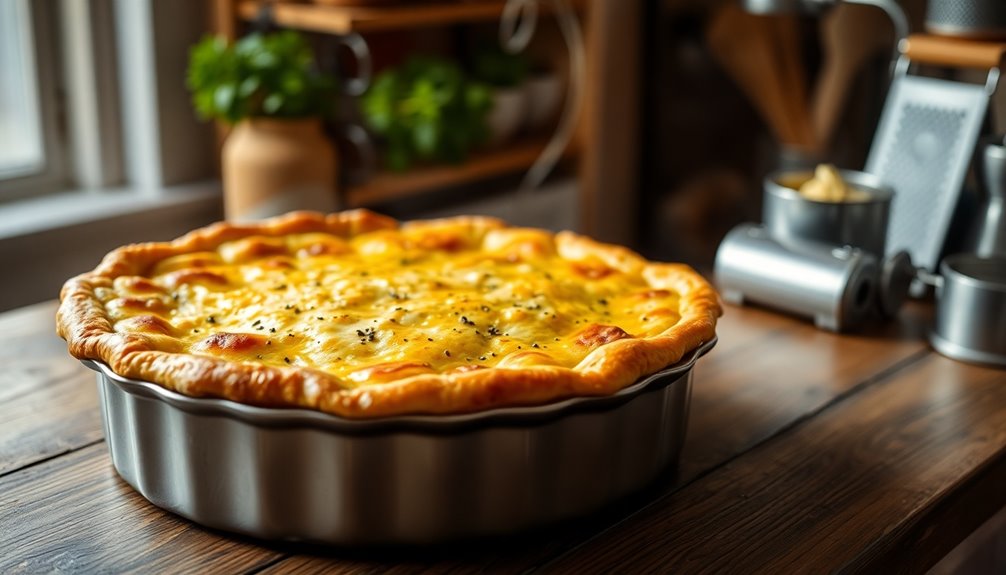
As you prepare to bake your Cacio E Pepe Pie, preheat your oven to 425 degrees F to guarantee a perfectly cooked and crispy crust.
Place your pie in a springform pan and cover it with foil during the first part of baking to prevent over-browning.
Bake until golden brown for about 35 to 45 minutes, and keep a close eye on the cheese on top, ensuring it's melted and bubbling.
If you want an extra crispy finish, activate the broiler for an additional 2 to 3 minutes.
Once it's done, let cool for 10 to 15 minutes before slicing. This step helps the pie set and makes serving easier.
Enjoy the deliciousness!
Step 5. Let Cool Before Slicing
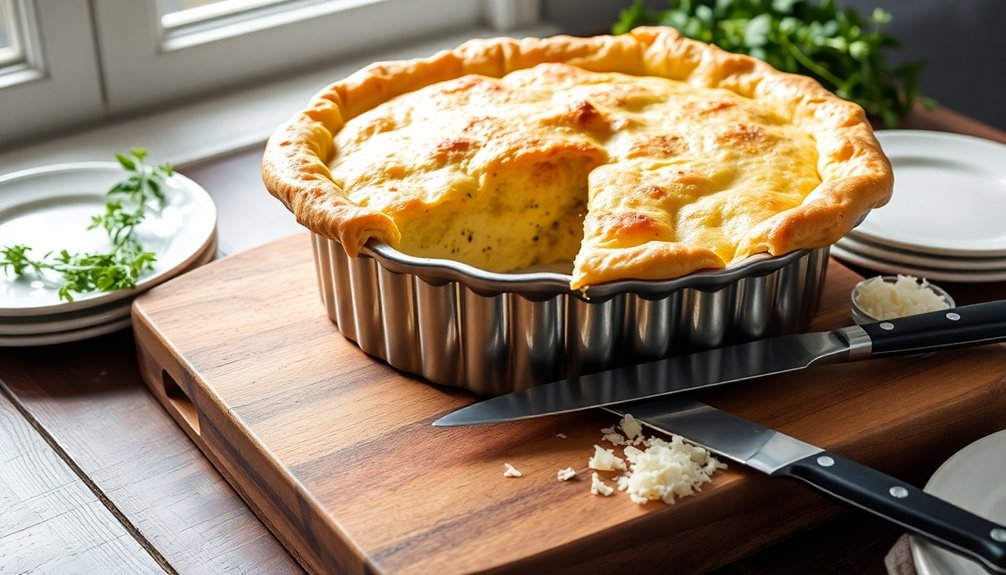
Allowing your Cacio E Pepe Pie to cool for 10 to 15 minutes is essential for achieving the perfect slice. This cooling time helps the pie set and firm up, making slicing much easier.
If you slice too soon, you risk a rubbery texture and messy presentation, as the cheese won't have stabilized yet. While the pie cools, you can prepare any additional toppings or side dishes you'd like to serve alongside it.
Once cooled, carefully release the pie from the springform pan to maintain its shape and texture. This way, when you finally serve it, you'll impress your guests with clean cuts and a delightful combination of flavors.
Enjoy your perfectly sliced Cacio E Pepe Pie!
Final Thoughts
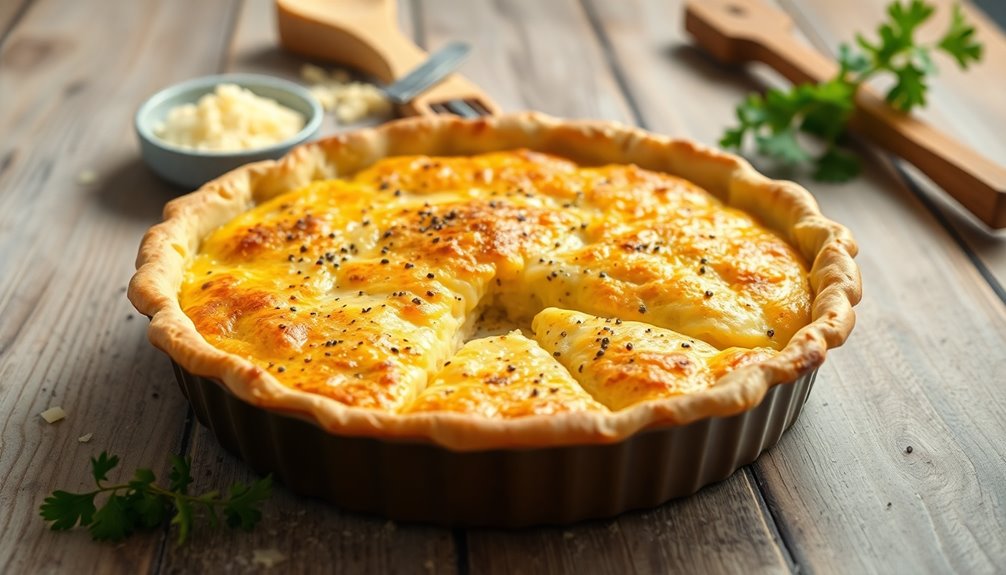
While Cacio e Pepe Pie brings a delightful twist to classic Italian flavors, it's essential to reflect on how it fits into your dining experience.
This unique dish combines a crispy pasta crust with a rich mixture of cheeses like cheddar and Fontina, seasoned with kosher salt and black pepper. When the cheese is melted, you'll savor every bite.
It's a great idea for gatherings or weeknight meals, serving 6 to 8 people easily. However, some feedback suggests it could be much better with a side of sauce or fresh vegetables to add moisture.
Frequently Asked Questions
What Does Cacio E Pepe Mean in Italian?
Cacio e Pepe means "cheese and pepper" in Italian, reflecting the dish's simplicity and focus on two key ingredients.
When you hear the term, think of the rich, creamy flavor that comes from the combination of Pecorino Romano cheese and freshly cracked black pepper.
This classic Roman dish showcases how just a few quality ingredients can create a delicious and satisfying meal that's both comforting and elegant at the same time.
Where Did Stanley Tucci Eat Cacio E Pepe?
Stanley Tucci enjoyed Cacio e Pepe at Da Felice a Testaccio, a renowned pasta restaurant in Rome.
During his travels, he showcased this iconic dish, emphasizing its simplicity and deliciousness.
You'll appreciate how he described the experience, highlighting the restaurant's authentic atmosphere and the craftsmanship behind the dish.
If you ever find yourself in Rome, visiting Da Felice a Testaccio for their Cacio e Pepe should definitely be on your list!
Why Is Cacio E Pepe Hard to Make?
They say, "The devil's in the details," and that's especially true with Cacio e Pepe.
It's tough to perfect because achieving a creamy emulsion between cheese and pasta water requires precision. If you grate the cheese too coarsely or add it at the wrong time, you'll end up with clumps instead of a smooth sauce.
Plus, dialing in the right amount of black pepper is essential; too much can ruin the dish entirely.
What Is the Secret to Cacio E Pepe?
The secret to cacio e pepe lies in using high-quality aged Pecorino Romano cheese and freshly cracked black pepper.
You've got to emulsify the cheese with pasta water to create a creamy sauce that clings to the pasta.
Cooking the pasta al dente is essential; it absorbs flavors while keeping a slight bite.
